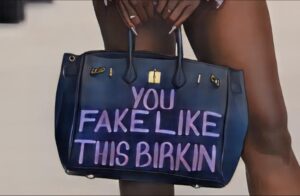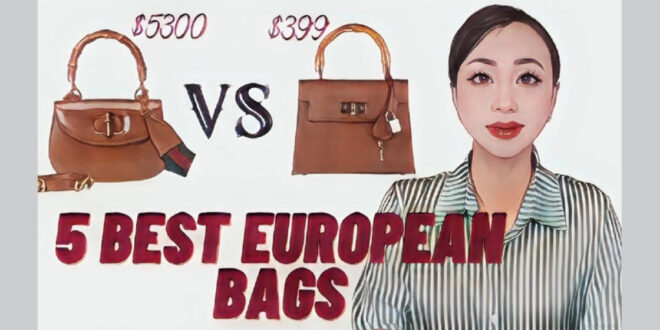The $38,000 Illusion
Let’s start with a simple question: What’s the real cost of that $38,000 Hermès Birkin bag? Spoiler alert — it’s not what you think. Directly out of the factory, the total cost to produce that bag? Around $1,400.
So where’s the rest of that price coming from? Branding. Marketing. Perception. Over 90% of the price is for the logo, the luxury illusion, and not necessarily for craftsmanship or materials.
Chinese TikTok Exposes the Truth

I ended up on “Chinese warehouse TikTok” — and baby, they are airing ALL the luxury secrets. These manufacturers are showing how luxury goods are made, how much they really cost, and how you can get the same quality for a fraction of the retail price. Chanel cosmetics? $5 to produce in China. That same product retails for $50 to $200 once that logo is slapped on.
Have you seen TikTok shops with Nike, Gucci, and more? Yup. It’s not a knock-off — it’s the same factory, same materials, same production line.
“Made in Italy”? Think Again
Here’s the tea: Many luxury items are not made in France or Italy like we’ve been led to believe. These brands have been secretly using Chinese factories for decades. Some Chinese manufacturers are now revealing exact locations, OEM partners, and supplier lists.
Even crazier? The exotic leather for many of those designer bags — like alligator and snakeskin — comes from Nigeria, specifically Kano. The bag might be assembled in China, but the material? Straight from Africa.
Why We Crave Luxury
 Let’s be honest — owning luxury is about status. It’s soft power. A Gucci belt or Prada bag makes many feel seen, admired, successful. In the U.S., designer goods are aspirational. They say, “I’ve made it.”
Let’s be honest — owning luxury is about status. It’s soft power. A Gucci belt or Prada bag makes many feel seen, admired, successful. In the U.S., designer goods are aspirational. They say, “I’ve made it.”
But here’s the kicker: we don’t question the origin or quality, as long as it comes with a European label. Because Europe is seen as the gold standard, and China… not so much.
What Happened? A Brief History of the Shift
The luxury world started shaking after Trump’s tariffs. When the U.S. made it harder for China to do business, China clapped back with petty precision.
They decided: Forget the middlemen. If Europe and the U.S. don’t respect us, we’ll go direct to consumer. They started pulling the curtain back — exposing sourcing, costs, and profit margins.
This was the ultimate Uno reverse.
Globalization: Who Really Benefited?
A Chinese manufacturer broke it down:
Nike shoes cost $10 to make in China. They retail for $150.
Stanley cups cost $1 to make. Retail: $50+.
Who’s profiting? Not the Chinese factories. It’s American brands and retailers, making 10 to 100 times the factory cost.
From Designer Bags to… $1 Laundry Pods?
 American citizens are catching on. One user said she found 50 laundry pods for $1 — the same ones branded as Tide or Gain. In the U.S.? $20+.
American citizens are catching on. One user said she found 50 laundry pods for $1 — the same ones branded as Tide or Gain. In the U.S.? $20+.
Furniture? $3,000 to $6,000 in the States, $500–$800 from China. Cars? $50,000 here, $10,000 there — and more advanced. Even modular luxury homes were being sold for $11,000.
It’s clear: we’ve been duped.
Craft vs. Industry: The Hermès Defense
To be fair, not all luxury brands are the same. Hermès, for example, claims their products are not about industrial production, but about craftsmanship. Each bag takes 20–30 hours to make. If the artisan’s work isn’t perfect, the bag doesn’t make it to the store.
They argue this is not about speed, but about patience and quality.
Is It Just About Materials?
Another perspective says: Yes, Chinese factories can mimic the material and design. But luxury brands like Hermès? You’re paying for legacy — 200 years of history, not just the leather and stitching.
But is that history worth a 2,000% markup?
Be Smart, Not Just Seduced
A woman with business experience in China warns: Be cautious. Not all factories offer the same quality. While some Chinese producers rival high-end quality, others don’t. You need to vet your sources. Just because something comes from the same region doesn’t mean it’s the same product.
China’s Control and the TikTok Push
 Let’s not forget: China is a highly censored country. No Facebook. No WhatsApp. No Instagram. TikTok in China is completely different from what we see. And now suddenly, we’re being bombarded with low-price offers and factory links?
Let’s not forget: China is a highly censored country. No Facebook. No WhatsApp. No Instagram. TikTok in China is completely different from what we see. And now suddenly, we’re being bombarded with low-price offers and factory links?
That’s not a coincidence — it’s strategic. China needs our consumer dollars. They have the supply; we have the demand.
A Call for Critical Thinking
This isn’t about hating China or blindly supporting American corporations. It’s about waking up.
For decades, U.S. elites outsourced jobs to China — not for peace, not for diplomacy, but for profit. In the process, they hollowed out the American middle class. Meanwhile, China reinvested its profits into infrastructure, healthcare, and technology.
We got yachts, stock manipulation, and crumbling cities.
So… What Now?
Here’s the truth:
Luxury is a mindset.
Perception drives price.
The supply chain is global — but the control is not.
If we continue to believe a label equals quality, we’ll keep getting played.
Maybe it’s not another tariff we need.
Maybe it’s a revolution of awareness.
 Cmtv News News -Education – Entertainment – Sports
Cmtv News News -Education – Entertainment – Sports







